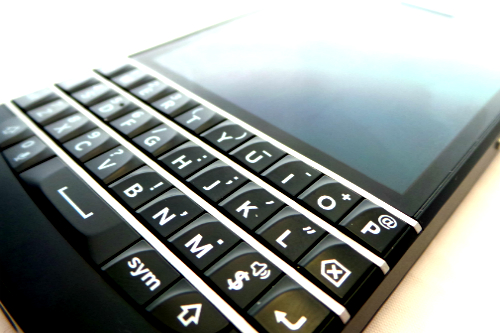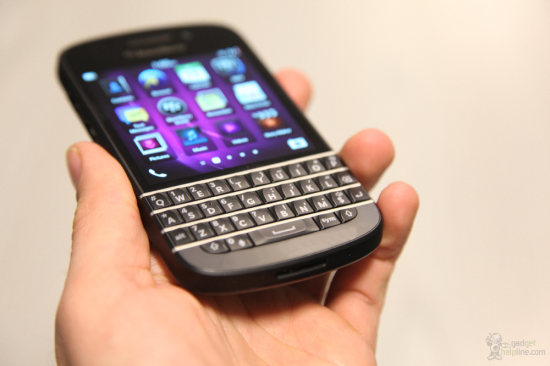The new BlackBerry Q10 is the second handset from the Canadian manufacturer this year as the firm looks to bring the QWERTY keyboard back into the limelight.
Running the latest BlackBerry 10 (BB10) software, the Q10, which also features a 3.1-inch super AMOLED touchscreen, will be the first handset to boast a physical keypad in BlackBerry’s latest wave of high-end smartphones.
BlackBerry claims that the Q10 has the potential to offer consumers the “best of both worlds”, housing all the new features of BB10 with the added functionality of the physical keys. However, BlackBerry has taken the mobile industry by surprise by pricing the Q10 at £579.95, which is higher than its full touchscreen flagship, the BlackBerry Z10.
There was a similar response to the Z10 with industry experts claiming the new features didn’t warrant such an expensive price tag.
Initial enthusiasm and demand quickly died down around the Z10 and it is now feared the same thing will happen with the Q10. Contract prices could crash in the same way as they did with the flagship, which in the long-run will dent the firm’s profits margins even further.
Adding further complications is the fact that countries like India only sell SIM-free devices – with so many other smartphone manufacturers targeting emerging markets such as this, the Q10 is unlikely to stand any chance of standing out from its cheaper rivals.
Only this week Nokia unveiled the low-end Asha 210; a full QWERTY device with social networking at its heart. The Finnish manufacturer has always been successful with its entry-level creations and as such, its latest offering could really blow the Q10 (and all BlackBerry’s hopes of achieving in developing markets) completely out of the water.
Fighting a losing battle?
When the Q10 was announced alongside the Z10 earlier this year many critics saw it as a safety net to appeal to users currently on BB6 OS and BB7 OS, and who are more than likely itching for a QWERTY upgrade. It also meant that should the Z10 fall at the first hurdle, the firm had something to fall back on.
But with such a steep price tag critics are now claiming that the QWERTY keypad, which was once the driving force of the firm’s success, could now be the final nail in the coffin for a company clearly struggling to catch up with its competitors.
It’s no secret that BlackBerry has pinned most of its hopes on the BB10 software and the firm has continued to remain optimistic despite delays during the development stage which pushed its release back to January this year.
It’s important to note that the BB10-toting Z10 has done better than expected, even selling out in some countries. Earlier this month Thorsten Heins, BlackBerry CEO, responded to claims the device had clocked up a high return rate: “Sales of the BlackBerry Z10 are meeting expectations and the data we have collected from our retail and carrier partners demonstrates that customers are satisfied with their devices.
“Return rate statistics show that we are at or below our forecasts and right in line with the industry.”
Regardless of these set-backs, BlackBerry is clearly intent on proving its critics wrong – a goal it is hoping the Q10 can help it accomplish. The device is certainly a huge improvement over BlackBerry’s previous QWERTY handsets, but in an era where large touchscreen phones are dominating the market, it raises questions as to whether potential consumers will be attracted to the device enough to switch from their current touchscreen handsets.
Keeping the faith
During the last decade BlackBerry’s QWERTY smartphones have always proved very popular with business users and in part it’s the loyalty of this user-base that has kept the firm strong. However, over the past few years the company has witnessed more and more of these users migrate to alternative platforms such as iOS and Android.
It’s likely many of these users will have reluctantly given up their old BlackBerry handsets in favour of more up-to-date software on faster devices – something BlackBerry wasn’t, until now, able to offer. While the Q10 is a hugely functional handset those now accustomed with their new mobile platforms are unlikely to switch back. When a consumer loses faith in a brand it’s always going to be a challenge to convince them things will be different second time round.
Mark Sue of RBC Capital Markets said that while the company has a chance to regain some ground it’s going to be difficult. “BlackBerry’s base is eroding, so time is of the essence and lower-priced devices for emerging markets and a larger screen model must also be in the line-up in order to target a broader audience,” the analyst wrote in a research note.
“The older demographics represent BlackBerry’s loyal user base and our study shows that the brand has quite a bit of work to do to attract new users.”
If BlackBerry’s user-base fails to grow once the Q10 has been released the company will find it increasingly difficult to continue turning over a decent profit and the negative effects of this are likely to ripple throughout all areas of the firm. Large brands like BlackBerry need and thrive off high-demand in order to justify the money it spends on developing its products, but despite its struggles the firm remains positive. Right now the Canadian manufacturer can but hope that reverting back to what originally made it a success can once gain help turn its fortunes around.

